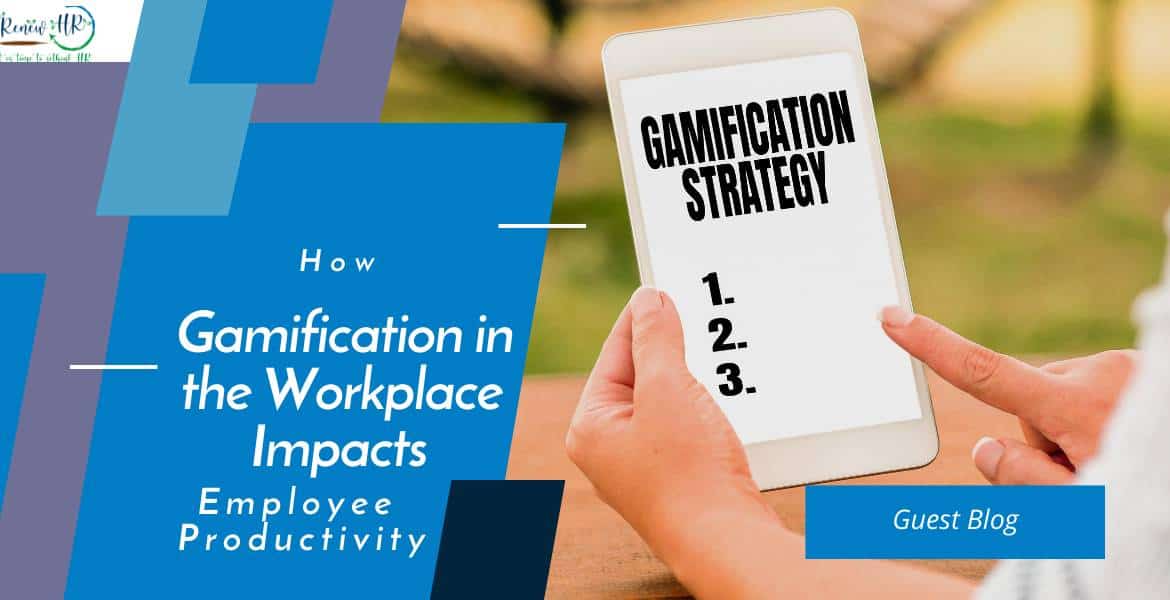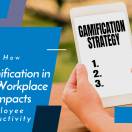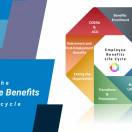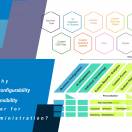[vc_row][vc_column width=”1/2″][vc_column_text]The concept of gaming is not just limited to fun and leisure because it enhances the functionality of teams and people in different places. The psychology behind gaming enforces the idea of engagement in group settings such as workplace and community management.
Gamification at the workplace is a wonderful tool to enhance productivity without imposing strict rules or regulations. Additionally, the mechanics of gaming encourages engagement and experience over the outcome.
Since the execution of gaming mechanics have plenty of benefits in the workplace, this article will focus on gamification in the workplace. Keep reading to know the benefits of executing this idea![/vc_column_text][/vc_column][vc_column width=”1/2″][vc_single_image image=”20462″ img_size=”full”][/vc_column][/vc_row][vc_row][vc_column][vc_column_text][/vc_column_text][/vc_column][/vc_row][vc_row][vc_column width=”1/2″][vc_single_image image=”20464″ img_size=”full”][/vc_column][vc_column width=”1/2″][vc_column_text]
Contents
What is gamification in the workplace?
Gamification is the practice of introducing gaming mechanics in concepts like learning, training, and employee engagement. This methodology empowers an organization with features like storytelling, problem-solving, and fun reward programs. The purpose of this concept is to encourage a healthy work culture within the organization so that employees feel motivated to contribute.
[/vc_column_text][/vc_column][/vc_row][vc_row][vc_column][vc_column_text]Ultimately, the long-term goal is to make routine work less stressful for employees and assign them the tasks they enjoy. Furthermore, the program involves immediate rewards, recognition for every contribution, meaningful pulse surveys, and fair decision-making.
The program will make employment more enticing with so many wonderful features! [/vc_column_text][/vc_column][/vc_row][vc_row][vc_column width=”1/2″][vc_column_text]
Important game mechanics for the workplace
There is much more to gamification at the workplace than just making the office fun. Apart from making things interesting, it also streamlines and improves workflow.
This segment discusses some crucial gaming mechanics an organization can adopt to keep the employee at the center of everything.
[/vc_column_text][/vc_column][vc_column width=”1/2″][vc_single_image image=”20463″ img_size=”full”][/vc_column][/vc_row][vc_row][vc_column][vc_column_text]
- Points for progress: Achieving or excelling is not the purpose of this program. It motivates people to aim for progress, no matter how slow it is. Hence, the employees receive rewards for every step they take to learn something new and practice the lessons.
- Fair leader board: A leader board that does not differentiate between the top performers and those who are still learning. This system creates a leader board to recognize people with expertise in a particular area and make their contributions count.
- Continuous evaluation: The assessment does not depend on a particular task or project. Employees’ performance is noted and rewarded when they cross their previous benchmark.
- Achievements: A little appreciation goes a long way, and this is the central theme for executing gamification in the workplace. As a result, employees feel encouraged to learn when they receive rewards for every level they complete.
- LMS Platform: A good learning management system platform also helps streamline the entire process by reducing manual interference.
In light of the pointers mentioned above, the following section explains 12 surprising ways gamification in the workplace can improve employee engagement. [/vc_column_text][/vc_column][/vc_row][vc_row default_id=”themesflat_1649032114″ css=”.vc_custom_1649050127557{padding-top: 10px !important;padding-bottom: 10px !important;}”][vc_column width=”1/2″][vc_single_image image=”20466″ img_size=”full”][/vc_column][vc_column width=”1/2″][vc_column_text]
1. Simplifies work for managers
Usually, a team manager acts as a glue for the team to stay together by planning team huddles and engagement activities. But gamification relieves the manager of these duties. The gaming mechanics’ integration lets them track the performance and activities.
The technological intervention to executing gaming mechanics also delivers accurate and unbiased details about the employees. It is a trustworthy tracker for managers that saves a lot of time.
[/vc_column_text][/vc_column][/vc_row][vc_row][vc_column][vc_column_text]
2. Transparency
The concept eliminates the feeling of being left out when collecting points, badges and awards. While it is easy for the sales team to outshine themselves, others find it hard to showcase their contributions.
Gamification gives them the chance to gain recognition for their contributions and exceptional efforts in the workplace. The system’s transparency further makes it easy for others to understand why and how someone stands out in the workplace.
3. Simple yet motivating
Gone are the days when leadership assessments and employee engagement were monthly tasks. Since companies have taken the initiative towards improving their work culture, game-focused platforms have become increasingly popular.
Currently, gamification encourages continuous and comprehensive assessment for every employee. This makes the entire process simple yet motivating for the team members to participate in.
4. Automated feedback
After automation of the employee engagement process and performance tracking system, the feedback system also integrates with the platform. The company’s managers and other decision-makers receive periodic performance updates.
Furthermore, it is fair because the judgment does not involve leaderboard ranking. Instead, the performance is compared to the employee’s previous benchmark in the workplace. This gives fair data about the improvement in every team member’s performance and eliminates the emotional bias from data.
5. Collective recognition
One of the biggest reasons for the downfall of an organization is its ignorance of an employee’s efforts. Recognition of efforts may seem minor, but it significantly affects an employee’s overall performance and growth.
Gamification focuses on collective recognition, which shows an employee’s growth graph and specifies their area of excellence. This further helps the organization encourage team members to give their best.
6. Clear calls to action
By adopting experience-based engagement, everything follows the automation mode. This enhances non-core activities in the organization, such as employee onboarding and performance improvement program.
The company’s workflow becomes streamlined when manual intervention reduces at multiple stages. This ensures a quick feedback system without involving anybody to guide the process.
The step-by-step procedure is fed into the system even for a performance improvement program. Hence, employees can utilize the portal efficiently and get proper guidance through each session.
7. Liberty and choice
Without gamification, a company adopts many methods to enhance employee engagement. But does it always work? The fact that other methodologies don’t give people a choice leads to their eventual failure.
When the company tries to impose something on employees as a part of a reward program, they feel burdened and try to avoid it. Moreover, many employees lose interest in the program and take part half-heartedly.
Unlike other methodologies, gamification gives a choice and makes the program voluntary. Therefore, the ability to choose and the option to do things voluntarily is a subconscious way of motivating people to do it more seriously.
8. Better learning and training programs
Since many corporate companies encourage employees to upskill through e-learning programs, gamification gives a new perspective. Instead of hustling between the work shifts, deadlines, and courses, gamification allows self-paced learning by adopting a different methodology.
Since the learning and training program’s sole purpose is upskilling human resources, the workplace adopts new techniques to assess the employee’s knowledge base. This does not make the course an additional liability for the person. Moreover, they learn the subject seriously when stringent deadlines do not bind them.
9. Balanced work culture
More often than not, employees have to wear multiple hats at their workplace. However, they are masters of only a few tasks, and gamification distinguishes this part.
It doesn’t seem unfair to other employees when the company assigns a task or gives category-based rewards for delivering a good performance. This is because others receive awards for being excellent at something else.
This culture strikes a balance and creates a sense of integrity in the workplace where employees feel comfortable reaching out to others for help.
10. Social interaction and teamwork
While the competition is still alive after gamification at the workplace, it allows team members to develop healthy bonds alongside competing against each other.
Everybody may not be like-minded here, but they can find strength in their differences through social interaction and engagement. A healthy workplace is all about cultivating a sense of belonging.
11. Fosters innovation
With a streamlined performance tracker and automated system, the employees are pushed to stand out in the workplace by thinking out of the box. An employee will feel curious to add multiple elements to routine work.
Gamification is not necessarily a comfortable system that makes everything easy. Instead, it makes everything exciting and gives every team member the space they deserve to express their creative ideas.
12. Brand building
Gamification is an emerging concept, and corporate culture is slowly adapting. In such a situation, the companies already practicing the concept can create a different image for themselves in the market.
Ultimately, this encourages employees to feel empowered while working at the organization. Therefore, it improves internal communication, attracts investors, brings better opportunities, and delivers better facilities to the employees.
The concept develops a healthy workplace for the employees and makes it worthwhile to be associated with the organization. [/vc_column_text][/vc_column][/vc_row][vc_row][vc_column width=”1/2″][vc_column_text]
Final verdict
Employee engagement changes the workplace dynamics as it brings an employee closer to the company’s business goals. Once the employees understand the vision and mission of the company, it becomes easy for them to align their efforts accordingly.
By doing this, they grow professionally and get rewarded and recognized for all their efforts. Therefore, gamification in the workplace adds experience and motivation, which drives an employee to keep working hard. [/vc_column_text][/vc_column][vc_column width=”1/2″][vc_single_image image=”20465″ img_size=”full”][/vc_column][/vc_row]













